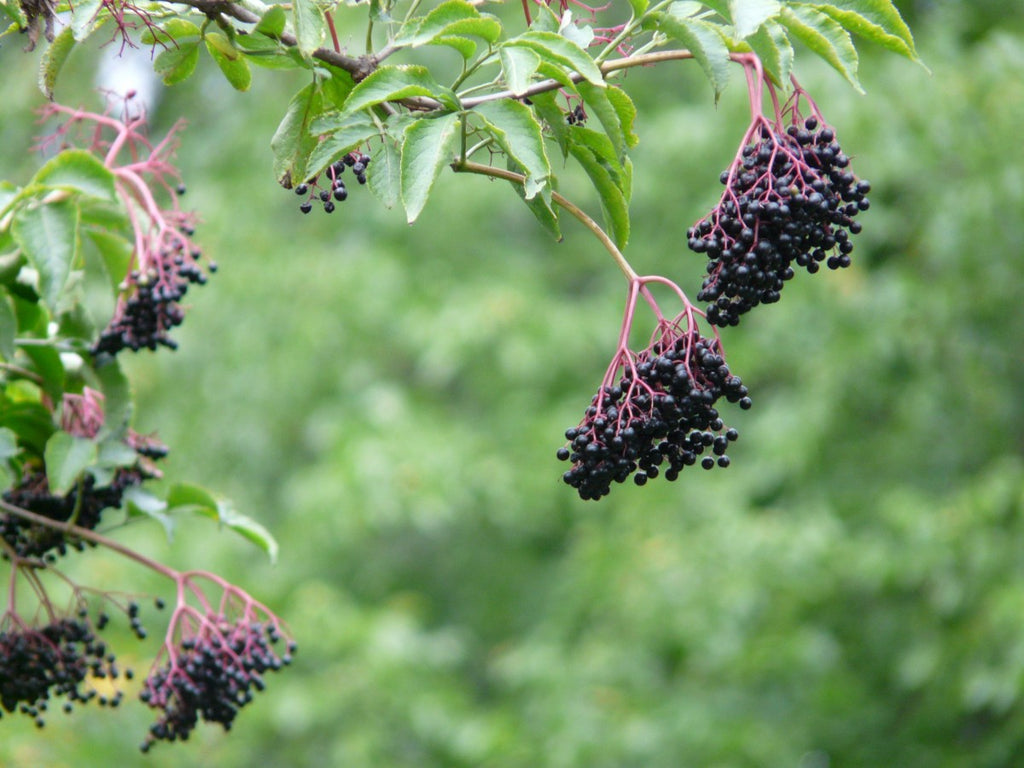Everything You Need to Know about Elder (Sambucus nigra)
It’s fall.
We shared an article about the beauty of the season a couple of weeks ago, but that’s not the only reason that we’re excited.
Autumn is harvest season and there are a few special herbal that we’re thrilled about this time of year—one of those is Elderberry.
We’ve written about Elderberry before, but we haven’t given you the whole, organized picture of the Elder Tree and there are several usable parts to this friend, so today we want to share the Elder monograph with you.
A monograph is an organized account of pure information, it’s where healthcare practitioners research from their sources and place information relevant to their practice.
You’ll see everything here from traditional uses to ancient beliefs held about a plant. Before a traditional medicine person offers a plant to another living being, he or she learns as much about the history, use, and energy of a plant to make sure it aligns with the health promotion of the individual.
Without further ado here’s the low-down on Elder.
Elder—Sambucus nigra
Family: Caprifoliaceae
Planetary connection: Venus
Plant Description:
- large shrub/small tree with masses of white/yellow umbels of small flowers
- dark blue/black berries
Note: don’t confuse with the red berry elder! TOXIC
How To Grow: full sun, rich soil (adaptable), lots of moisture drainage
When to Collect:
Flowers: In the morning after the dew drys - they blacken, ferment, and bruise easily.
Berry: when ripe, cut the whole umbel from the node
Energetics: cool, dry - yin - water
Actions:
flowers: diaphoretic, anticatarrhal, antispasmodic, astringent, alterative, anti-inflammatory, antirheumatic, antiseptic, carminative, decongestant, depurative, diaphoretic, digestive, diuretic, emollient, expectorant, febrifuge, glactagogue, laxative, vulnerary, vasodilator, tonic
berry: diaphoretic, diuretic, laxative, anticatarrhal, alterative, anti-inflammatory, antirheumatic, antiseptic, antispasmodic, antiviral, depurative, expectorant, nervine, restorative, tonic
Leaf: purgative, expectorant, diuretic, diaphoretic, emollient, vulnerary (external)
Notable Constituents:
Flower/Berry: triterpenes (ursolic, oleanic acid, sterols a-b anyrin), fixed oils, phenolic acids, pectic, sugars
Leaf: triterpenes (ursolic, oleanic acid, sterols a-b anyrin), eyonogenetic glycosides (sambunigrn), flavonoids (kaempferol) quercetin and glycosides (hyperoside, isoquercitrin, rutin), alkanes, tannins, fatty acids
Traditional Uses:
Leaf:
- topically: bruises, chillblains, sprains, wounds
Berry:
- See flower for more berry indications
- Syrup has been used for more than 2000 years for colds, flu, coughs
- rheumatism (tincture in red wine vinegar)
- flavonoids help bind and disarm hemagglutinins, tiny spiky things that help viruses get into cells
- Used with hair-dye to rejuvenate the color
Flower:
- colds, influenza (antiviral)
- upper respiratory tract and sinuses
- increases cytokine production; strengthen cell membranes
- with peppermint at the beginning cold
- tea: shingles
- Bath: cold infusion - brightener and softening
- Skin: firming, toning, lightening
- dry dampness
- relieve congestion
- helps clear heat
- asthma
- chicken pox
- gout
- hayfever
- resp infection
- compress for headache relief
Edible:
- berries and flowers are edible (and tasty, though the berries are tart)
- berries are very good for you and promote healthy elimination.
- flowers used in food as a pretty and healthful garnish yum!
Topical Use:
- anti-inflammatory wash
- eyewash
- gargle
Other:
- Ancients Celts consider elder a sacred tree, symbolic of birth and death
- Many cultures do not use it for firewood or for woodworking and see it as bad luck to do so
- Planted by homes to encourage prosperity, happy marriage, healthy children, and protection from lightning and evil forces
- Insect Repellent: Crush leaves and rub them on you
- Leaf tea cooled can be used to prevent aphid infection in the garden!
Flower Essence:
- Imparts inner strength and increases self-esteem
- Calms fears and anxieties - engenders a sense of being nurtured and supported by a strong and stable inner energy
- Good for people who feel overcrowded by fear
Contraindications:
- fluid depletion
- Diarrhea (fresh elder can be used as a laxative)
- Avoid consuming bark and root, they’re medicinal but high purgative.
- Know the species that you’re using - many are poison.
Do you have anything to add to the Elderberry Monograph? Tell us in the comments!
References:
Hoffmann, D. (2003). Medical herbalism: The science and practice of herbal medicine. Rochester, Vt.: Healing Arts Press.
Zee, B. (1994). The green witch herbal: Restoring nature's magic in home, health & beauty care. Rochester, Vt.: Healing Arts Press ;.
Hobbs, C., & Gardner, L. (n.d.). Grow it, heal it: Natural and effective herbal remedies from your garden or windowsill.
Culpeper, N. (1955). Complete herbal: Consisting of a comprehensive description of nearly all herbs with their medicinal properties and directions for compounding the medicines extracted from them. London, New York: Foulsham.
Alfs, M. (2003). 300 Herbs Their Indications and Contraindications. New Brighton, MN: Old Theology Book House.
Mars
McIntyre


0 comments